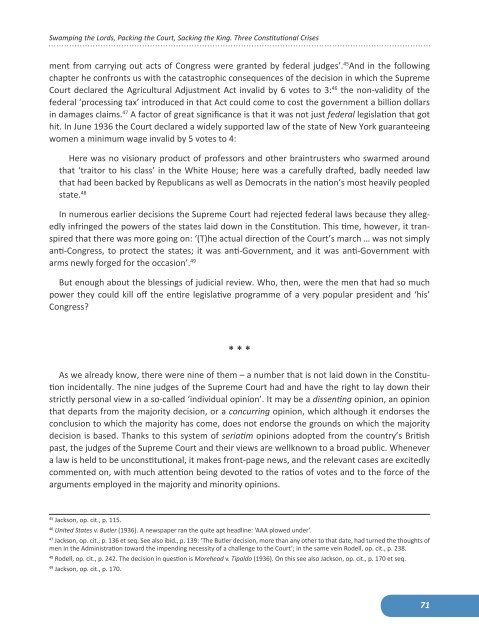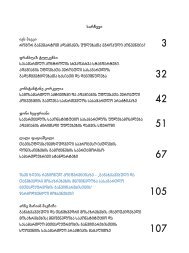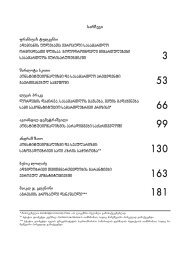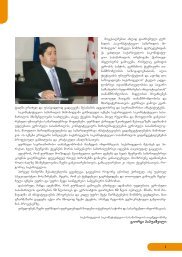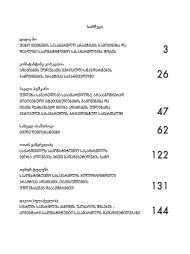Contents - Constitutional Court of Georgia
Contents - Constitutional Court of Georgia
Contents - Constitutional Court of Georgia
You also want an ePaper? Increase the reach of your titles
YUMPU automatically turns print PDFs into web optimized ePapers that Google loves.
Swamping the Lords, Packing the <strong>Court</strong>, Sacking the King. Three <strong>Constitutional</strong> Crises<br />
ment from carrying out acts <strong>of</strong> Congress were granted by federal judges’. 45 And in the following<br />
chapter he confronts us with the catastrophic consequences <strong>of</strong> the decision in which the Supreme<br />
<strong>Court</strong> declared the Agricultural Adjustment Act invalid by 6 votes to 3: 46 the non-validity <strong>of</strong> the<br />
federal ‘processing tax’ introduced in that Act could come to cost the government a billion dollars<br />
in damages claims. 47 A factor <strong>of</strong> great significance is that it was not just federal legislation that got<br />
hit. In June 1936 the <strong>Court</strong> declared a widely supported law <strong>of</strong> the state <strong>of</strong> New York guaranteeing<br />
women a minimum wage invalid by 5 votes to 4:<br />
Here was no visionary product <strong>of</strong> pr<strong>of</strong>essors and other braintrusters who swarmed around<br />
that ‘traitor to his class’ in the White House; here was a carefully drafted, badly needed law<br />
that had been backed by Republicans as well as Democrats in the nation’s most heavily peopled<br />
state. 48<br />
In numerous earlier decisions the Supreme <strong>Court</strong> had rejected federal laws because they allegedly<br />
infringed the powers <strong>of</strong> the states laid down in the Constitution. This time, however, it transpired<br />
that there was more going on: ‘(T)he actual direction <strong>of</strong> the <strong>Court</strong>’s march … was not simply<br />
anti-Congress, to protect the states; it was anti-Government, and it was anti-Government with<br />
arms newly forged for the occasion’. 49<br />
But enough about the blessings <strong>of</strong> judicial review. Who, then, were the men that had so much<br />
power they could kill <strong>of</strong>f the entire legislative programme <strong>of</strong> a very popular president and ‘his’<br />
Congress?<br />
* * *<br />
As we already know, there were nine <strong>of</strong> them – a number that is not laid down in the Constitution<br />
incidentally. The nine judges <strong>of</strong> the Supreme <strong>Court</strong> had and have the right to lay down their<br />
strictly personal view in a so-called ‘individual opinion’. It may be a dissenting opinion, an opinion<br />
that departs from the majority decision, or a concurring opinion, which although it endorses the<br />
conclusion to which the majority has come, does not endorse the grounds on which the majority<br />
decision is based. Thanks to this system <strong>of</strong> seriatim opinions adopted from the country’s British<br />
past, the judges <strong>of</strong> the Supreme <strong>Court</strong> and their views are wellknown to a broad public. Whenever<br />
a law is held to be unconstitutional, it makes front-page news, and the relevant cases are excitedly<br />
commented on, with much attention being devoted to the ratios <strong>of</strong> votes and to the force <strong>of</strong> the<br />
arguments employed in the majority and minority opinions.<br />
45 Jackson, op. cit., p. 115.<br />
46 United States v. Butler (1936). A newspaper ran the quite apt headline: ‘AAA plowed under’.<br />
47 Jackson, op. cit., p. 136 et seq. See also ibid., p. 139: ‘The Butler decision, more than any other to that date, had turned the thoughts <strong>of</strong><br />
men in the Administration toward the impending necessity <strong>of</strong> a challenge to the <strong>Court</strong>’; in the same vein Rodell, op. cit., p. 238.<br />
48 Rodell, op. cit., p. 242. The decision in question is Morehead v. Tipaldo (1936). On this see also Jackson, op. cit., p. 170 et seq.<br />
49 Jackson, op. cit., p. 170.<br />
71


